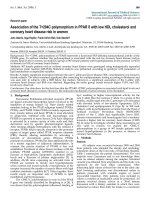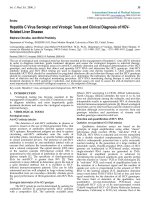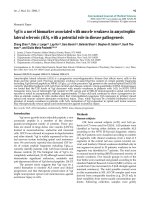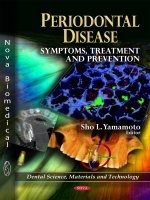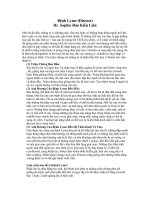LETHIHUNG(202150450) huntingtons disease (1)
Bạn đang xem bản rút gọn của tài liệu. Xem và tải ngay bản đầy đủ của tài liệu tại đây (1.1 MB, 22 trang )
Huntington disease
LE THI HUNG, JEONBUK NATIONAL UNIVERSITY
Biometris
Quantitative Methods brought to Life
Outline
I . Huntington disease
II . Pathogenesis
III. Symptoms
IV . Diagnosis
V . Treatment
VI . Emerging therapies
Biometris
Quantitative Methods brought to Life
2
I. Huntington disease
Definition: an autosomal dominant, neurodegenerative condition
Causes: pathogenic repeat expansion of CAG trinucleotide in exon 1 of the hunting gene (HTT) on chromosome 4
3
I. Huntington disease
The average age at diagnosis
Meta-analyses show a worldwide prevalence of 2.7 per
100,000 with the highest
is
rates in Western
49 years old
populations and lowest among Asians
Both male and female, have a 50%
risk of inheriting the
faulty gene
4
II. Pathogenesis
5
III. Symptoms
Table 2. Motor symptoms of HD
6
III. Symptoms
Table 3. Motor symptoms of HD
7
III. Symptoms
Cognitive symptoms:
Memory deficits
Psychomotor slowing
Impairment in executive, perceptual and spatial skills
The ability to communicate diminishes
Common speech difficulties include dysarthria, with poor articulation and slurring of words, slow production of words,
poor speech initiation and difficulty organising thoughts
8
III. Symptoms
9
III. Symptoms
10
III. Symptoms
11
III. Symptoms
12
IV. Diagnosis
CAG repeats ≥ 40 to determine a positive test
Diagnostic testing can determine the nature of clinical presentation and guide treatment decisions
MRI brain comparison
and measurements in
control person and
Person with
Huntington’s Disease
Predictive testing those at risk for HD, usually a family history
13
V. Treatment
There are no treatment to stop or reverse Huntington’s disease.
However, some medications can help keep symptoms under control:
-
Tetrabenazine
-
Antipsychotic drugs
-
Antidepressants
-
Tranquilizers
Better to do exercise.
14
[REF: Tasuku Matsuoka and Masakazu Yashiro, 2018]
VI. Emerging therapies
HTT lowering
HTT modulation
Immunomodulation
Immunomodulation
Cell replacement
Deep
Deep brain
brain stimulation
stimulation
Synaptic modulation
Other medical therapies
<Scheme of HD emerging therapies>
15
VI. Emerging therapies
1.
HTT lowering
-RNA- based approaches
-- One of the most intriguing and promising emerging therapy.
-- Only the use of ASOs has reached clinical stages of development.
-DNA- based approaches:
-- ZFPs were able to reduce mHTT levels and an HD-like behavioral phenotype. These models has high CAPrepeat numbers (115-160 repeats). (no clinical studies of ZFPs in HD).
-- CRISPR – Cas9: reduce DNA breaks at sequence- specific sites.
16
VI. Emerging therapies
2. HTT modulation
Selisistat
- A SirT1 (silent information regulator T1) inhibitor.
-
A selective decrease of mHTT levels (Drosophia and mouse models) may specially increase the rate of
clearance of mHTT.
PBT2:
-
An 8-hydroxyquinolin.
-
PBT2 treatment in an HD nematode and mouse model improved motor ability and ameliorated the toxic
effects of polyglutamine aggregation.
17
VI. Emerging therapies
3.
Immunomodulation
-Laquinimod
-- An immunomodulatory drug originally studied for the treatment of relapsing-remitting multiple sclerosis.
--
A significant reduction of caudate atrophy and whole brain atrophy that was most evident in early HD.
-Semaphorin 4AD (SEMA4D):
-- A transmembrane signaling protein that modulates pathways of neuroinflammation.
-- The blockage of SEMA4D using a monoclonal antibody (mAb67-2) reduced striatal, corpus, callosal and
cortical atrophy, improved behavioral measures (in an HD mouse model study).
18
VI. Emerging therapies
4. Synaptic modulation
Pridopidine
- Have low D2 affinity and much higher affinity for the sigma-1 receptor (SIG1R)
- SIG1R agonist (PRE084) used in neuronal cells expressing mHTT improved survival.
Phosphodiesterase 10A inhibitors
- A member of the PDE enzyme family to hydrolyze cAMP, cGMP vital for modulating cyclic signaling
pathways impairment of several transcription factors including the cAMP response element-binding protein
(CREB)
BN82451
Reduce neuronal death, improve mitochondrial dysfunction and reduce neuroinflammation
19
VI. Emerging therapies
5. Other medical therapies
SRX246
- SRX246 is a novel vasopressin 1a (V1a) receptor antagonist being evaluated for the treatment of specific mood
disorders
Cysteamine
-Transglutaminase (TGA) inhibitor TGA promotes aggregation by crosslinking the expanded polyglutamine tract of
mHTT
6. Deep brain stimulation
-
Significant reduction of chorea
7. Cell replacement therapy
-
Replace lost cellsreversing disease or modifying progression
Replace the degenerated striatal MSNs and reconstruct neural circuity
20
Key references
•
[1] Hassaan (2019). Emerging therapies in Huntington’s disease, Expert Review of Neurotherapeurics, Vol 19(10), 983-995 .
•
[2] Pierre, Samentha, Mark et.al (2018). Huntington’s disease: Neuropsychiatric manifestations of Huntington’s disease,
Australasian Psychiatry, Vol 26(1), 366-375.
•
[3] Anthony J. Hannan (2018. Synaptopathy, circuitopathy and the computational biology of Huntington’s disease, BMC biology, 16,
71-73.
21
Thank you very much!

